In this article I’ll be sharing my expertise on paddle boarding with dogs. For many dog owners, spending time with their furry friends is an essential part of life.
Whether it’s taking them on walks or playing fetch in the park, dogs are a constant source of joy and companionship.
And for those who love to paddle board, bringing their canine companions along for the ride can make the experience even more fulfilling.
However, before you can hit the water with your dog, it’s important to ensure that you’ve taken the necessary steps to train them properly. Not only does this ensure their safety, but it also makes the experience more enjoyable for both you and your furry friend.
In this blog post, I’ll be providing a step-by-step guide on how to train your dog to sit on a paddle board, as well as the safety precautions you should take while on the water.
I’ll also be sharing some tips on choosing the best paddle board for your dog and the characteristics of dogs that are best suited for paddle boarding.
Whether you’re a seasoned paddle boarder or just starting out, this guide will help you and your dog have a safe and enjoyable experience on the water.
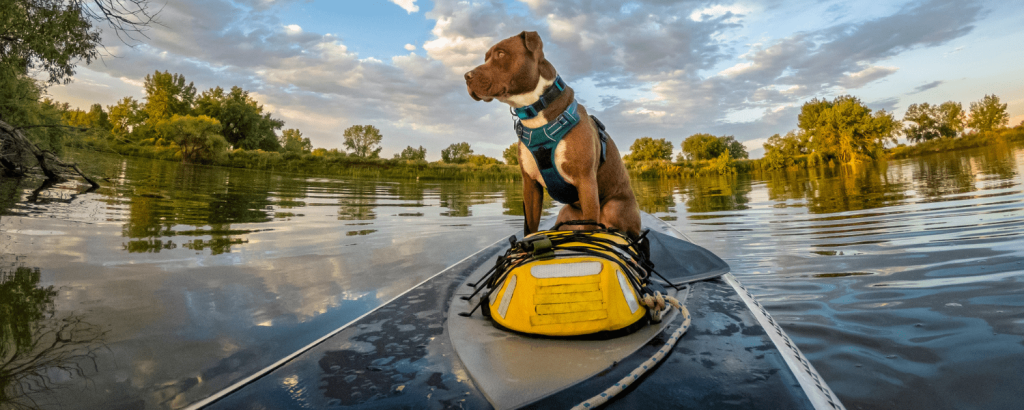
Preparing for Training
One of the keys to successfully training your dog to sit on a paddle board is preparation. This includes choosing the right paddle board for you and your dog, familiarizing your dog with the paddle board on land, and starting with basic obedience training.
What kind of paddle board is best for dogs?
When choosing a paddle board for your dog, stability is key. Look for a board with a wide and flat surface area that will provide plenty of stability for both you and your furry companion.
Inflatable paddle boards are also a good option, as they tend to be more stable and durable than solid boards.
Another feature to consider is the size of the board. You’ll want to choose a board that is large enough to accommodate both you and your dog comfortably. A board that is at least 10 feet long and 32 inches wide is a good starting point.
Finally, make sure the paddle board has a non-slip surface to prevent your dog from slipping or sliding while on the board.
How to get your dog to be comfortable on a paddle board?
Once you’ve chosen the right paddle board, it’s important to familiarize your dog with it on land before hitting the water. Allow your dog to explore the board and get comfortable with it. You can also use treats and positive reinforcement to create a positive association with the board.
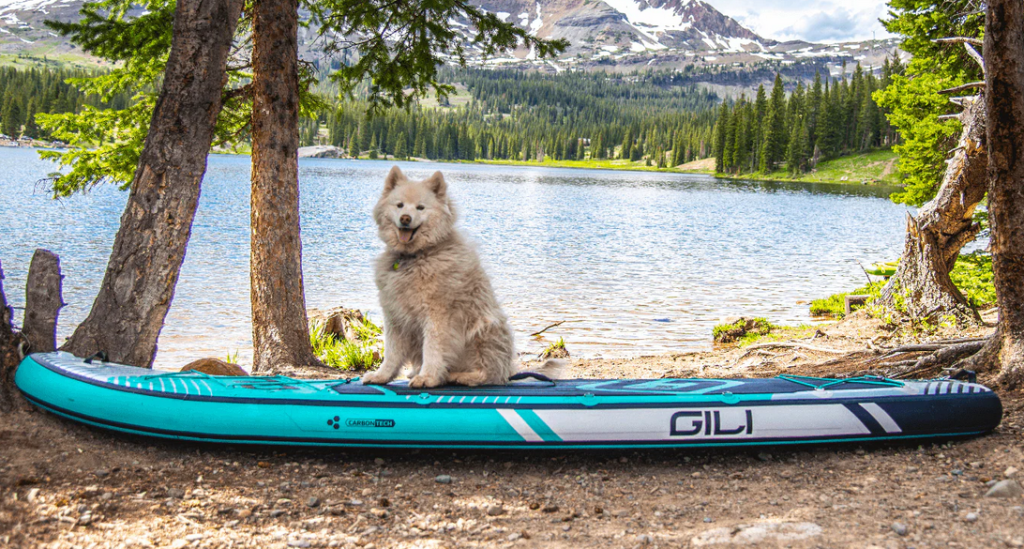
In addition to familiarizing your dog with the paddle board, it’s important to start with basic obedience training.
This includes commands such as sit, stay, and come, which will be essential when training your dog to sit on the paddle board.
With the right preparation, you and your dog can hit the water with confidence and enjoy a safe and fun paddle boarding experience.
Teaching Your Dog to Sit on a Paddle Board
Now that you’ve prepared your dog for paddle boarding, it’s time to start training them to sit on the board. It’s important to remember that this process takes time and patience, so don’t rush your dog or get frustrated if they don’t get it right away.
Here are some steps you can follow to train your dog to sit on a paddle board:
1. Begin by having your dog sit on the board while it is on land.
Start by placing the board on a flat surface and encourage your dog to sit on it. Use treats and positive reinforcement to make the experience enjoyable for your dog.
2. Gradually move to calm shallow waters.
Once your dog is comfortable sitting on the board on land, move to calm shallow waters. Keep the board close to shore and hold it steady while your dog sits on it.
Again, use treats and positive reinforcement to encourage your dog to stay on the board.
3. Use treats and positive reinforcement to encourage your dog to sit and stay on the board.
As you progress, use treats and positive reinforcement to encourage your dog to sit and stay on the board for longer periods of time.
Be patient and take things slow, gradually increasing the amount of time your dog spends on the board.
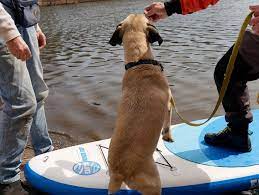
4. Practice getting on and off the board with your dog.
Once your dog is comfortable sitting on the board, practice getting on and off the board together. Use treats and positive reinforcement to encourage your dog to stay calm and still while you climb onto the board.
Remember to always use a leash to prevent your dog from jumping off the board, and never force your dog to stay on the board if they’re uncomfortable.
With patience and persistence, you and your dog can learn to enjoy a safe and fun paddle boarding experience together.
Safety Precautions While Paddle Boarding with Your Dog
While paddle boarding with your dog can be a fun and rewarding experience, it’s important to take necessary safety precautions to ensure the safety of both you and your furry companion.
Here are some safety tips to keep in mind:
1. Always wear a life jacket.
Make sure both you and your dog are wearing properly fitting life jackets. This can prevent accidents and ensure that you both stay afloat in case of an emergency.
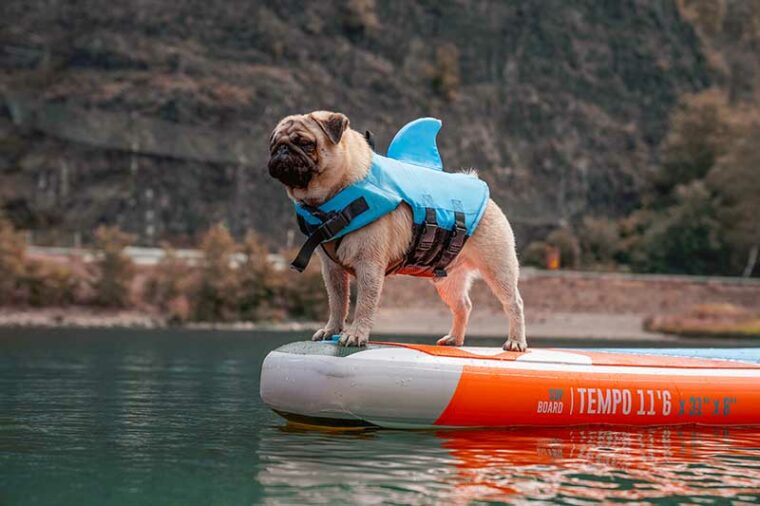
2. Keep your dog on a leash.
There is one question I get asked a lot… Should I keep my dog on a leash?
While your dog may be well-trained, unexpected situations can arise on the water.
Keep your dog on a leash to prevent them from jumping off the board and swimming away, and to ensure they stay safe while on the water.
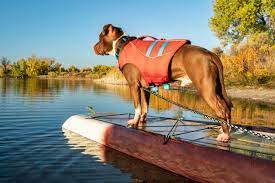
3. Check the weather and water conditions.
Before heading out on the water, check the weather forecast and water conditions. Avoid paddle boarding in strong winds, currents, or rough waters, as these conditions can be dangerous for you and your dog.
4. Bring plenty of water and snacks.
Just like humans, dogs can get dehydrated and hungry on the water. Make sure to bring plenty of water and snacks for both you and your dog to stay hydrated and energized.
5. Stay alert and aware of your surroundings.
Keep an eye out for other boats, kayaks, and paddle boarders in the area. Be aware of your surroundings and stay alert to prevent accidents and collisions.
By following these safety precautions, you can ensure a safe and enjoyable paddle boarding experience for both you and your furry companion.
what are the Best Paddle Boards for Dogs?
Not all paddle boards are created equal, and some are better suited for dogs than others. Here are some features to look for in a paddle board when paddle boarding with your furry friend:
1. Size and stability.
Look for a paddle board that is large enough and stable enough to accommodate both you and your dog. A wider board will offer more stability and space for your dog to move around on.
2. Traction pad.
A traction pad or deck pad is a great feature to have when paddle boarding with your dog. This provides your dog with a non-slip surface to stand or sit on, which can prevent them from slipping or falling off the board.
3. Durable material.
Choose a paddle board that is made from durable materials that can withstand scratches, bites, and other wear and tear from your dog.
4. Leash attachment points.
Look for a paddle board that has multiple leash attachment points. This can help keep your dog secure and prevent them from jumping off the board.
5. Easy to clean.
Choose a paddle board that is easy to clean, especially if your dog sheds a lot. Look for a board with a smooth surface that can be easily wiped down with a damp cloth.
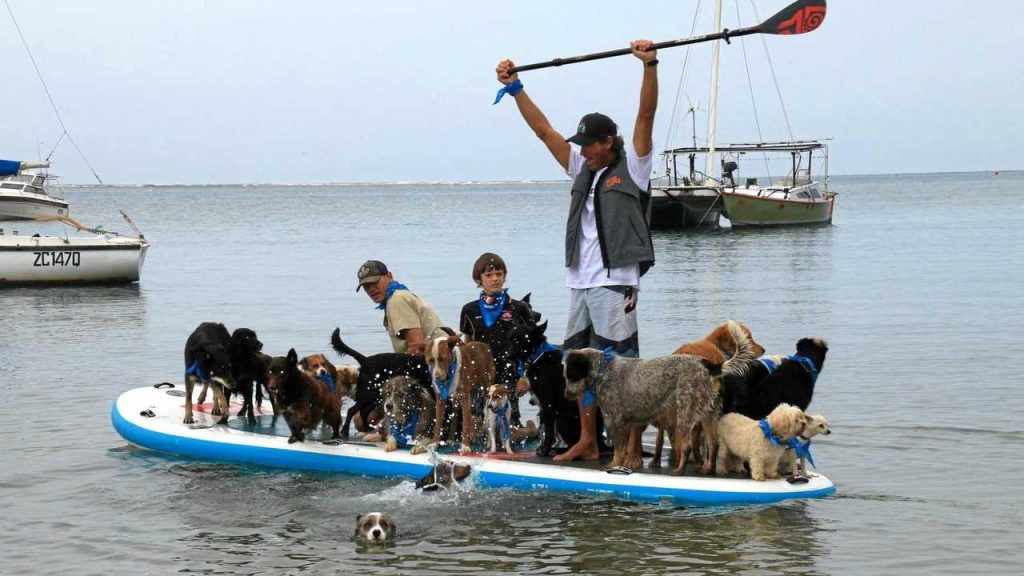
Some recommended paddle boards for dogs include:
- the Isle Explorer inflatable paddle board
- the BOTE HD Aero inflatable paddle board
- the NRS Thrive inflatable paddle board.
These boards are designed with features that make them ideal for paddle boarding with your furry friend.
Remember, it’s important to choose a paddle board that is suitable for your dog’s size and weight.
Always check the weight capacity of the board before purchasing and ensure that it can safely accommodate both you and your dog.
What Type of Dogs are Best for Paddle Boarding?
While many dogs can enjoy paddle boarding, some breeds are better suited for this activity than others. Here are some dog breeds that tend to do well on the water:
1. Retrievers: Golden Retrievers, Labrador Retrievers, and other retriever breeds tend to love the water and are often great swimmers.
They are also typically easy to train and obedient, which can make them great companions on a paddle board.
2. Poodles: Standard Poodles and other poodle breeds are also great swimmers and tend to have a lot of energy. They are intelligent and easy to train, which can make them great paddle boarding companions.
3. Bulldogs: While they may not be the best swimmers, Bulldogs are typically calm and well-behaved on a paddle board.
They are also less likely to jump off the board than other breeds, making them a good choice for those who want a more relaxed paddle boarding experience.
4. Portuguese Water Dogs: These dogs were originally bred for fishing and water rescue and are known for their love of the water.
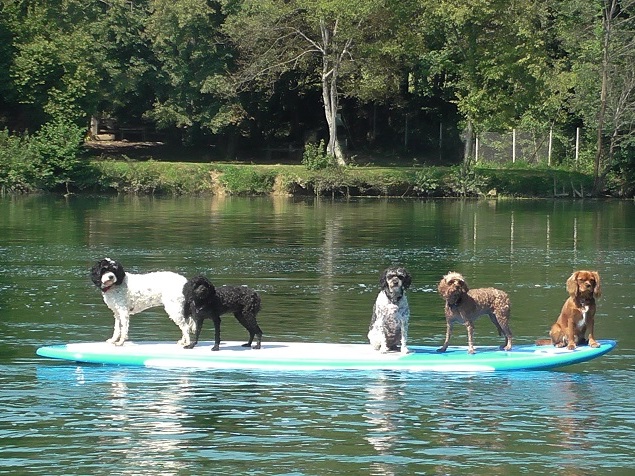
They are also highly trainable and obedient, making them great paddle boarding companions.
Remember, it’s important to take your dog’s individual personality and temperament into account when deciding whether or not they are suited for paddle boarding.
Some dogs may be fearful or anxious on the water, while others may be overly energetic and difficult to control. Always consider your dog’s comfort and safety when taking them paddle boarding.
In conclusion
Paddle boarding with your dog can be a fun and rewarding experience. Whether you’re an experienced paddle boarder or a beginner, with the right training and equipment, you and your furry friend can enjoy the water together.
Remember to always consider your dog’s safety and comfort when taking them paddle boarding, and choose a board that is suitable for both you and your dog’s needs.
By following these tips and guidelines, you can create a memorable and enjoyable paddle boarding experience for both you and your canine companion.
FAQ
Here are some other common questions I get asked which haven’t been discussed above…
Q: How do I get my dog to wear a life jacket?
A: It’s important for your dog to wear a life jacket while paddle boarding. To get your dog used to wearing a life jacket, start by introducing it to them on land and let them sniff and explore it.
Once they are comfortable with it, gradually increase the amount of time they wear it and use positive reinforcement such as treats and praise.
Q: What if my dog falls off the paddle board?
A: If your dog falls off the paddle board, stay calm and try to guide them back onto the board as quickly as possible.
Use treats and positive reinforcement to encourage them to climb back onto the board. If your dog seems scared or hesitant, bring them back to shore and try again another time.
Q: How can I teach my dog to swim?
A: Not all dogs are natural swimmers, so it’s important to take it slow and make sure your dog is comfortable in the water.
Start in shallow water and use positive reinforcement such as treats and praise to encourage your dog to swim. You can also use a life jacket to help your dog stay afloat and build confidence in the water.



